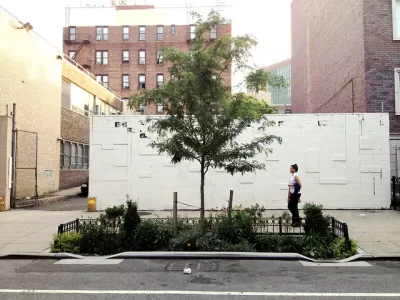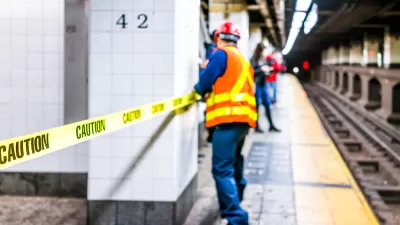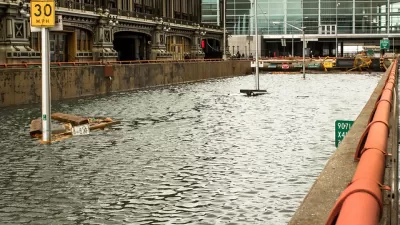To reduce the severity of disruptive subway flooding, the city can implement street-level solutions that absorb and redirect water before it reaches the train tunnels.

As climate change all but assures more catastrophic flooding in New York City, "experts say the city and the MTA can at least work on mitigating the worst of the floods by going green. Literally." To protect the city's subways and mitigate future floods, writes Dave Colon, "it’s incumbent on the city to create streets and sidewalks that can actually absorb water."
New York's subway system, according to the MTA, "can only handle rainfall of 1.75 inches per hour — an amount that used to be considered extremely rare, but isn’t anymore." In a 2018 lawsuit against Big Oil, the de Blasio administration acknowledged the increased risk by pointing out that "the number of days in New York City with rainfall at or above two inches is projected to increase by as much as 67% by the 2020s and the number of days with rainfall at or above four inches is projected to increase by as much as 67% by the 2020s and 133% by the 2080s."
Colon argues that "[s]treet design is a necessary, but neglected, weapon against flooding" that the city should implement more aggressively. And while experts praise the city's stormwater resiliency guide, Marcel Negret of the Regional Plan Association says the document takes "a siloed view of the transit system that the city relies on without owning," putting responsibility for flood prevention on the MTA without addressing street-level solutions like "street trees, bioswales and planters that manage excess stormwater."
FULL STORY: More Absorbent Streets Could Mean Less Flooded Subways

Planetizen Federal Action Tracker
A weekly monitor of how Trump’s orders and actions are impacting planners and planning in America.

Congressman Proposes Bill to Rename DC Metro “Trump Train”
The Make Autorail Great Again Act would withhold federal funding to the system until the Washington Metropolitan Area Transit Authority (WMATA), rebrands as the Washington Metropolitan Authority for Greater Access (WMAGA).

The Simple Legislative Tool Transforming Vacant Downtowns
In California, Michigan and Georgia, an easy win is bringing dollars — and delight — back to city centers.

The States Losing Rural Delivery Rooms at an Alarming Pace
In some states, as few as 9% of rural hospitals still deliver babies. As a result, rising pre-term births, no adequate pre-term care and "harrowing" close calls are a growing reality.

The Small South Asian Republic Going all in on EVs
Thanks to one simple policy change less than five years ago, 65% of new cars in this Himalayan country are now electric.

DC Backpedals on Bike Lane Protection, Swaps Barriers for Paint
Citing aesthetic concerns, the city is removing the concrete barriers and flexposts that once separated Arizona Avenue cyclists from motor vehicles.
Urban Design for Planners 1: Software Tools
This six-course series explores essential urban design concepts using open source software and equips planners with the tools they need to participate fully in the urban design process.
Planning for Universal Design
Learn the tools for implementing Universal Design in planning regulations.
Smith Gee Studio
City of Charlotte
City of Camden Redevelopment Agency
City of Astoria
Transportation Research & Education Center (TREC) at Portland State University
US High Speed Rail Association
City of Camden Redevelopment Agency
Municipality of Princeton (NJ)





























